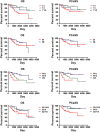Outcomes and predictive factors of prostate cancer patients with extremely high prostate-specific antigen level
- PMID: 24747988
- PMCID: PMC11823722
- DOI: 10.1007/s00432-014-1681-8
Outcomes and predictive factors of prostate cancer patients with extremely high prostate-specific antigen level
Abstract
Purpose: Prostate-specific antigen (PSA) is a useful biomarker of prostate cancer (PCa). High-risk localized PCa is defined using T stage, Gleason score (GS), and PSA. However, PSA level defining high-risk PCa is at most 20 ng/mL. In PCa patients with high PSA, it is unclear whether PSA itself can be a prognostic factor.
Methods: Of 642 patients who were diagnosed as PCa, 90 patients with PSA > 100 ng/mL were retrospectively analyzed. Patients were divided into three groups according to PSA level: very high (>1,000 ng/mL), moderately high (200-1,000 ng/mL), and slightly high (100-200 ng/mL).
Results: There were no significant differences in overall survival or PCa-specific survival (PCaSS) among the three groups. Regardless of PSA level, high M stage and GS significantly reduced PCaSS. When the risk classification was made using M stage and GS (high risk = M1 and GS ≥ 9, low risk = M0 and GS < 9, and intermediate risk = others), PCaSS was significantly different among high-, intermediate-, and low-risk groups with 5-year survival rates of 58.2, 80.6, and 100 %, respectively. Although there were no differences in treatment performed during the castration-resistant stage, patients undergoing alternative anti-androgen and zoledronic acid treatment had better PCaSS after being castration-resistant.
Conclusions: As PSA could not be a prognostic factor in PCa patients with high PSA > 100 ng/mL, the novel risk classification using M stage and GS may help clinicians to predict PCaSS and to plan follow-up schedules after diagnosis.
Figures






References
-
- D’Amico AV, Whittington R, Malkowicz SB et al (1998) Biochemical outcome after radical prostatectomy, external beam radiation therapy, or interstitial radiation therapy for clinically localized prostate cancer. JAMA 280:969–974 - PubMed
-
- Ferlay J, Parkin DM, Steliarova-Foucher E (2010) Estimates of cancer incidence and mortality in Europe in 2008. Eur J Cancer 46:765–781 - PubMed
-
- Hinotsu S, Akaza H, Usami M et al (2007) Current status of endocrine therapy for prostate cancer in Japan analysis of primary androgen deprivation therapy on the basis of data collected by J-CaP. Jpn J Clin Oncol 37:775–781 - PubMed
MeSH terms
Substances
LinkOut - more resources
Full Text Sources
Other Literature Sources
Medical
Research Materials
Miscellaneous

